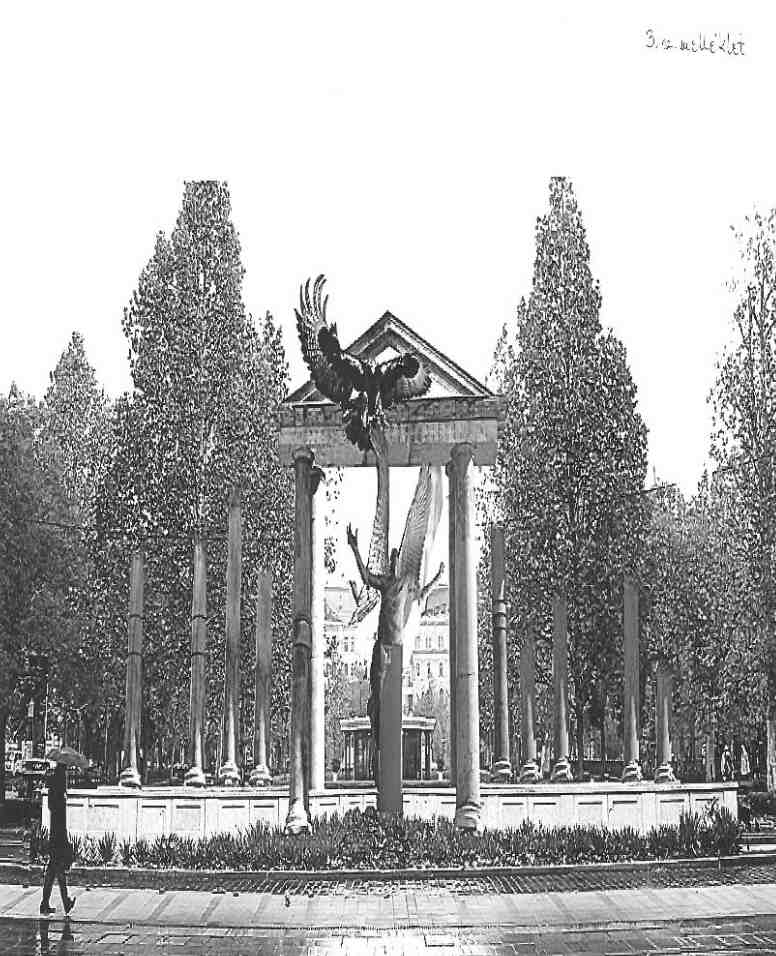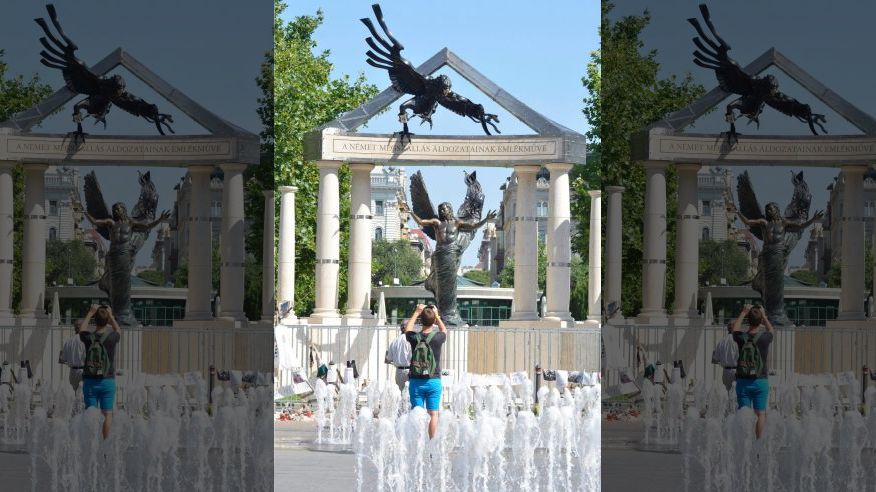A new monument dedicated to the victims of the German occupation of Hungary during WW II is seen at Szabadsag (Liberty) square in downtown Budapest.
Sunday, July 20, 2014:
In the middle of the night and guarded by police, workers have set up the main elements of the disputed memorial to the 1944 occupation of Hungary by Nazi Germany. The memorial meant to commemorate all victims of the German invasion, which also resulted in the deportation of over 430,000 Hungarian Jews to death camps like Auschwitz, has been widely criticized by Jewish groups and others, mainly because it is seen as an effort to downplay Hungarians’ role in the Holocaust.
Source: The Associated Press, Photo/MTI, Noemi Bruzak.
Artistic meaning and political background
The memorial was errected during the year of Holocaust Remembrance, the hungarian government has announced for 2014. Primeminister Viktor Mihály Orbán brushed off the criticism, saying it is "not a Holocaust memorial but a tribute to all the victims of the German occupation".
In 19 January 2014 the oppositional Internet Blog Pusztaranger had reported about the artistic meaning and the political background of the plan:
The Hungarian government has resolved that, on the 70th anniversary of the German occupation on 19 March 2014, a monument will be set up on Budapest’s Freedom Square.
[...]
There was no call for tenders, but the artist, sculptor Péter Párkányi, was commissioned by the Prime Minister’s office and endorsed by a committee of government officials; the two artistic consultants, Miklós Melocco and György Benedek are members of the National Academy of Art (MMA) and friends of Párkányi.
 His composition consists of an aggressively swooping German imperial eagle (black bronze) and the Archangel Gabriel with broken wings in the pose of a Christ-like victim symbolising Hungary (light bronze). In the background are 13 pillars, citing the monument on Budapest’s Heroes’ Square. The inscription on the pediment: "German Occupation of Hungary 19 March 1944". On one pillar (so not the main subject but an also ran): "In Memory of All Victims".
His composition consists of an aggressively swooping German imperial eagle (black bronze) and the Archangel Gabriel with broken wings in the pose of a Christ-like victim symbolising Hungary (light bronze). In the background are 13 pillars, citing the monument on Budapest’s Heroes’ Square. The inscription on the pediment: "German Occupation of Hungary 19 March 1944". On one pillar (so not the main subject but an also ran): "In Memory of All Victims".
From the description of artist Péter Párkányi:
"The composition portrays this historic event not with contemporary figures and people, but by harnessing art history, using its allegorical figures to cite characters from cultural history. It shows oppressor and oppressed, occupier and occupied. The sculpture is dramatic without pools of blood, weapons and corpses appearing on the square. It portrays two cultures: the one, which considers itself stronger (and is in any case more aggressive), […] is supported on the other, quieter figure with softer lines, the figure of the Archangel Gabriel as the incarnation of Hungary – in cultural and religious history he is the man of God, God’s strength is the divine power. […]
The figure of the Archangel Gabriel is beautiful and calm. His body is perfect, his expression shows no fear. His face is calm, his eyes closed. We do not know whether he is asleep or dreaming […] The composition declares that his dream will become a nightmare. His posture reveals the vanquished. His outspread arms lead us to think in three directions: capitulation, crucifixion, but also […] gestures of blessing, which can be a last message and, simultaneously, a new beginning."
[…] We are to identify with the “beautiful, perfect, calm” golden eagle in light bronze, the positive, beaming national self-image; the holy national body has closed its eyes and beamed itself up into an eternal innocence. The victims of the German occupation, on the other hand, are represented by mutilated pillars and fragments of pillars – abstract, faceless and painless.
Source: Pusztaranger

